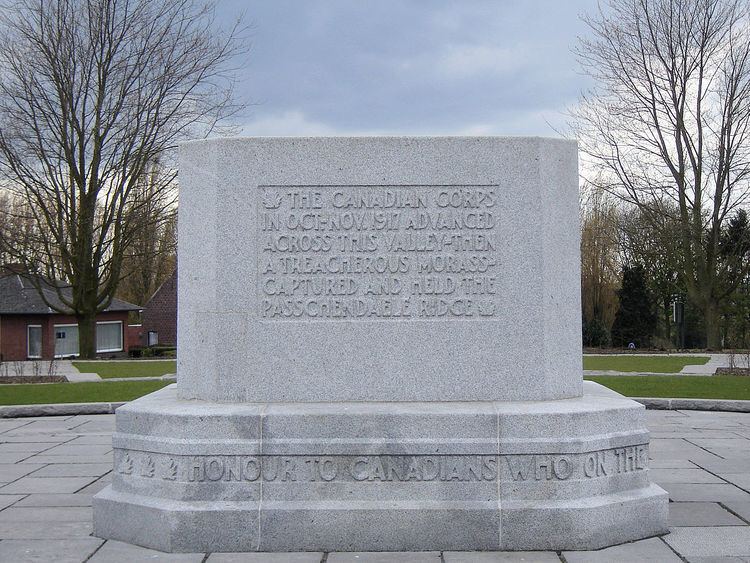 | ||
Location near Passendale, Belgium on the site of the Crest Farm | ||
The Passchendaele Memorial is a Canadian war memorial that commemorates the actions of the Canadian Corps in the Second Battle of Passchendaele of World War I. The memorial is located on the former site of Crest Farm, an objective captured by the 4th Canadian Division during the assault of 30 October 1917.
Contents
The battle
The Second Battle of Passchendaele was the culminating and final attack of the Third Battle of Ypres during World War I. The battle took place in the Ypres Salient area of the Western Front, in and around the Belgian town of Passchendaele, between 26 October 1917 and 10 November 1917. The Canadian Corps was tasked with relieving the exhausted II Anzac Corps, continuing the advance started with the First Battle of Passchendaele and ultimately capturing the town of Passchendaele itself.
In the low ground west of the Passchendaele Ridge three months of constant shelling had blocked the watercourses that normally provided drainage. When rain began falling, the battlefield was transformed into a quagmire of mud making movement extremely difficult. The mud was to become one of the defining features of the battle for soldiers on both sides, and did a great deal to hamper offensive operations.
The Canadian Corps operation was executed in series of three attacks each with limited objectives, delivered at intervals of three or more days. The execution dates of the phases were tentatively given as 26 October, 30 October and 6 November, with a smaller action later executed on 10 November. The attack was successful in capturing the German-held high ground along the Passchendaele-Westrozebeke ridge but the campaign was forced to end just short of Westrozebeke itself. The Second Battle of Passchendaele cost the Canadian Corps 15 654 casualties with over 4 000 dead, in 16 days of fighting. Nine Victoria Crosses, the highest military decoration for valour awarded to British and Commonwealth forces, were awarded to Canadians for actions during the battle.
Location & Design
The Passchendaele Memorial sits at the site of 'Crest Farm' which was the location of some of the most stubborn German resistance the Canadians faced at Passchendaele, and indeed, in their Great War experience.
The Memorial park is a small keyhole shaped area located on the aptly named 'Canadalaan' on the southwest fringe of Passendale village. Fittingly, maple trees and a hedge of holly line the edges of the park and well kept lawns and stone pathways surround the low circular flagstone terrace that the granite memorial block rests on. From the centre of the memorial grounds one can look up the Canadalaan to see the rebuilt church of Passendale and in the opposite direction, down a long avenue of trees, the rebuilt spires of Ypres.
Selection
At the end of the war, The Imperial War Graves Commission (now Commonwealth War Graves Commission) granted Canada 8 sites, 3 in France and 5 in Belgium, on which to erect memorials. Each site represented a significant Canadian engagement and for this reason it was originally decided that each battlefield would be treated equally and graced with identical monuments. The Canadian Battlefields Memorials Commission was formed in November 1920 to discuss the process and conditions for holding a memorial competition for the European sites. In October 1922, the submission of Toronto sculptor and designer Walter Seymour Allward was selected as the winner of the competition, and the submission of Frederick Chapman Clemesha placed second. The commission selected Vimy Ridge in France as the preferred site of Allward's design. Clemesha's Brooding Soldier design was selected for the remaining sites but was later, for a number of reasons, erected only at Sint Julien in Belgium. The remaining sites at Passchendaele and Hill 62 in Belgium and Le Quesnel, Dury, Courcelette and Bourlon Wood in France each received a granite block memorial marker inscribed with a brief description of the battle in both English and French.
